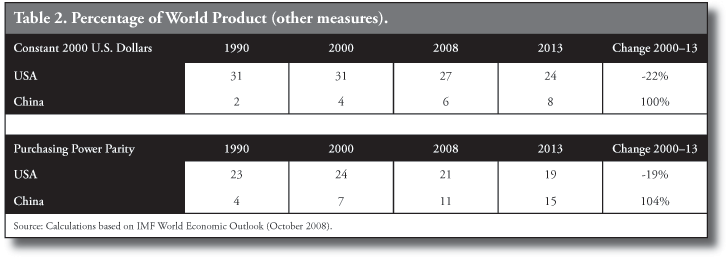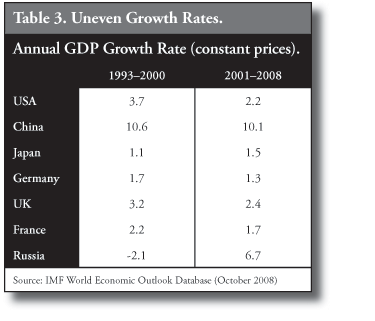Empire Falls
Mini Teaser: The United States is in unprecedented decline. Future generations will look back at the past decade as the beginning of the end of American hegemony.
AMERICA IS in unprecedented decline. The self-inflicted wounds of the Iraq War, growing government debt, increasingly negative current-account balances and other internal economic weaknesses have cost the United States real power in today's world of rapidly spreading knowledge and technology. If present trends continue, we will look back at the Bush administration years as the death knell for American hegemony.
Since the cold war, the United States has maintained a vast array of overseas commitments, seeking to ensure peace and stability not just in its own neighborhood-the Americas-but also in Europe and Asia, along with the oil-rich Persian Gulf (as well as other parts of the world). Simply maintaining these commitments requires enormous resources, but in recent years American leaders have pursued far more ambitious goals than merely maintaining the status quo. The Bush administration has not just continued America's traditional grand strategy, but pursued ambitious objectives in all three major regions at the same time-waging wars in Iraq and Afghanistan, seeking to denuclearize North Korea and expanding America's military allies in Europe up to the borders of Russia itself.
For nearly two decades, those convinced of U.S. dominance in the international system have encouraged American policy makers to act unilaterally and seize almost any opportunity to advance American interests no matter the costs to others, virtually discounting the possibility that Germany, France, Russia, China and other major powers could seriously oppose American military power. From public intellectuals like Charles Krauthammer and Niall Ferguson to neoconservatives like Paul Wolfowitz and Robert Kagan, even to academicians like Dartmouth's William Wohlforth and Stephen Brooks, all believe the principal feature of the post-cold-war world is the unchallengeable dominance of American power. The United States is not just the sole superpower in the unipolar-dominance school's world, but is so relatively more powerful than any other country that it can reshape the international order according to American interests. This is simply no longer realistic.
For the past eight years, our policies have been based on these flawed arguments, while the ultimate foundation of American power-the relative superiority of the U.S. economy in the world-has been in decline since early on in the Bush administration. There is also good reason to think that, without deliberate action, the fall of American power will be more precipitous with the passage of time. To be sure, the period of U.S. relative decline has been, thus far, fairly short. A healthy appreciation of our situation by American leaders may lead to policies that could mitigate, if not rectify, further decline in the foreseeable future. Still, America's shrinking share of world economic production is a fact of life and important changes in U.S. grand strategy are necessary to prevent the decline in America's global position from accelerating.
Although the immediate problems of war in Iraq and Afghanistan, al-Qaeda's new sanctuary in western Pakistan, Iran's continued nuclear program and Russia's recent military adventure in Georgia are high-priority issues, solutions to each of them individually and all of them collectively will be heavily influenced by America's reduced power position in the world. Most important, America's declining power means that the unipolar world is indeed coming to an end, that major powers will increasingly have the strength to balance against U.S. policies they oppose and that the United States will increasingly face harsh foreign-policy choices. Like so many great powers that have come and gone before, our own hubris may be our downfall.
FROM ROME, Imperial China, Venice, Spain, France, Great Britain and the Soviet Union to the United States today, the rise and fall of great nations has been driven primarily by relative economic strength. As Paul Kennedy so ably describes in his classic The Rise and Fall of Great Powers, the more international commitments a state has, the more its power matters and hence the more relative economic strength it needs.
Although scholars have long debated its nuances, the basic definition of power in international politics is simple: power is the aggregate resources a state has at its disposal to achieve its aims, the most important of which are to defend its national interests, both at home and abroad.1 But it is not only how much power a state has that matters. It is also how much power a state has relative to other states. This is true in any rough-and-tumble environment. A Ford Explorer is a powerful vehicle-unless it collides with a Mack Truck. In international politics, power does not ensure success. But, power certainly helps.
At any given moment, U.S. power is heavily dependent on the size and quality of its military forces and other current power assets. A successful grand strategy, however, must work for the long haul and so depends on the power a state is able to produce in the future.
Over time, America's power is fundamentally a result of its economic strength. Productive capacity-defined by indicators such as wealth, technology and population size-is a prerequisite for building and modernizing military forces. The United States, like any state, may choose to vary the degree to which its productive capacities are used to create military assets. But it is the economy as a whole that constrains the choice. And the size of the economy relative to potential rivals ultimately determines the limits of power in international politics. Major assessments of this relative position have long turned heavily on a single statistic: America's share of world economic product.


Advocates of extending America's unipolar dominance are well aware of the central importance of the economic foundations of American power and routinely present detailed statistics on the U.S. share of world product. The basic notion is simple: take U.S. domestic product in any year and divide it by the aggregate total of the gross domestic product of all states in the world. To measure gross domestic product, the unipolar-dominance school prefers to compare every country's output in current-year U.S. dollars, a method that tends to show America is much further ahead of other countries than alternative measures. Indeed, the most recent call for America to exploit its hegemonic position (published in 2008) rests on the presumption of U.S. dominance based on the current-year dollar figures.2 By this metric, in 2006 the United States had 28 percent of world product while its nearest most likely competitor, China, had 6 percent. Looks pretty good for America, right?
Alas, single-year "snapshots" of America's relative power are of limited value for assessing the sustainability of its grand strategy over many years. For grand-strategic concerns-especially how well the United States can balance its resources and foreign-policy commitments-the trajectory of American power compared to other states is of seminal importance.
For the sake of argument, let us start with the unipolar-dominance school's preferred measure of American hegemony, but look at the trajectory of the data over time. According to GDP figures in current U.S. dollars from the International Monetary Fund (IMF), the United States increased its share of world production during the 1990s, reached its apogee in 2000, and then began to steadily lose ground during the eight years of the Bush administration, with its relative power ultimately falling by nearly a quarter in the first decade of the twenty-first century. At the same time, the relative power of China, the state many consider America's most likely future rival, has grown consistently. If we look out as far as the IMF can see (2013), things get even worse-with the United States expected to continue declining and China to continue rising. The United States has been going through the first decade of the twenty-first century not stronger than before, but substantially weaker.

How good are the numbers? Economists commonly use two other methods to calculate GDP, constant-dollar calculations and purchasing power parity.3 Although each offers advantages and disadvantages, for our purposes what matters is that they form a lower bound of America's relative decline. And regardless of the metric, the trend is the same. Again using IMF figures, Table 2 shows the trajectory of the share of world product for the United States and China using both alternative measures.
Simply put, the United States is now a declining power. This new reality has tremendous implications for the future of American grand strategy.
THE EROSION of the underpinnings of U.S. power is the result of uneven rates of economic growth between America, China and other states in the world. Despite all the pro-economy talk from the Bush administration, the fact is that since 2000, U.S. growth rates are down almost 50 percent from the Clinton years. This trajectory is almost sure to be revised further downward as the consequences of the financial crisis in fall 2008 become manifest.
As Table 3 shows, over the past two decades, the average rate of U.S. growth has fallen considerably, from nearly 4 percent annually during the Clinton years to just over 2 percent per year under Bush. At the same time, China has sustained a consistently high rate of growth of 10 percent per year-a truly stunning performance. Russia has also turned its economic trajectory around, from year after year of losses in the 1990s to significant annual gains since 2000.
Image: Essay Types: First Draft of History
Essay Types: First Draft of History 